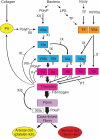Platelet polyphosphate: an endogenous activator of coagulation factor XII
- PMID: 20230417
- PMCID: PMC3043986
- DOI: 10.1111/j.1538-7836.2010.03832.x
Platelet polyphosphate: an endogenous activator of coagulation factor XII
Figures

References
-
- Macfarlane RG. An enzyme cascade in the blood clotting mechanism, and its function as a biochemical amplifier. Nature. 1964;202:498–9. - PubMed
-
- Davie EW, Ratnoff OD. Waterfall sequence for intrinsic blood clotting. Science. 1964;145:1310–2. - PubMed
-
- Broze GJ. Tissue factor pathway inhibitor. Thromb Haemost. 1995;74:90–3. - PubMed
-
- Pauer HU, Renné T, Hemmerlein B, Legler T, Fritzlar S, Adham I, Müller-Esterl W, Emons G, Sancken U, Engel W, Burfeind P. Targeted deletion of murine coagulation factor XII gene-a model for contact phase activation in vivo. Thromb Haemost. 2004;92:503–8. - PubMed
Publication types
MeSH terms
Substances
Grants and funding
LinkOut - more resources
Full Text Sources
Other Literature Sources

